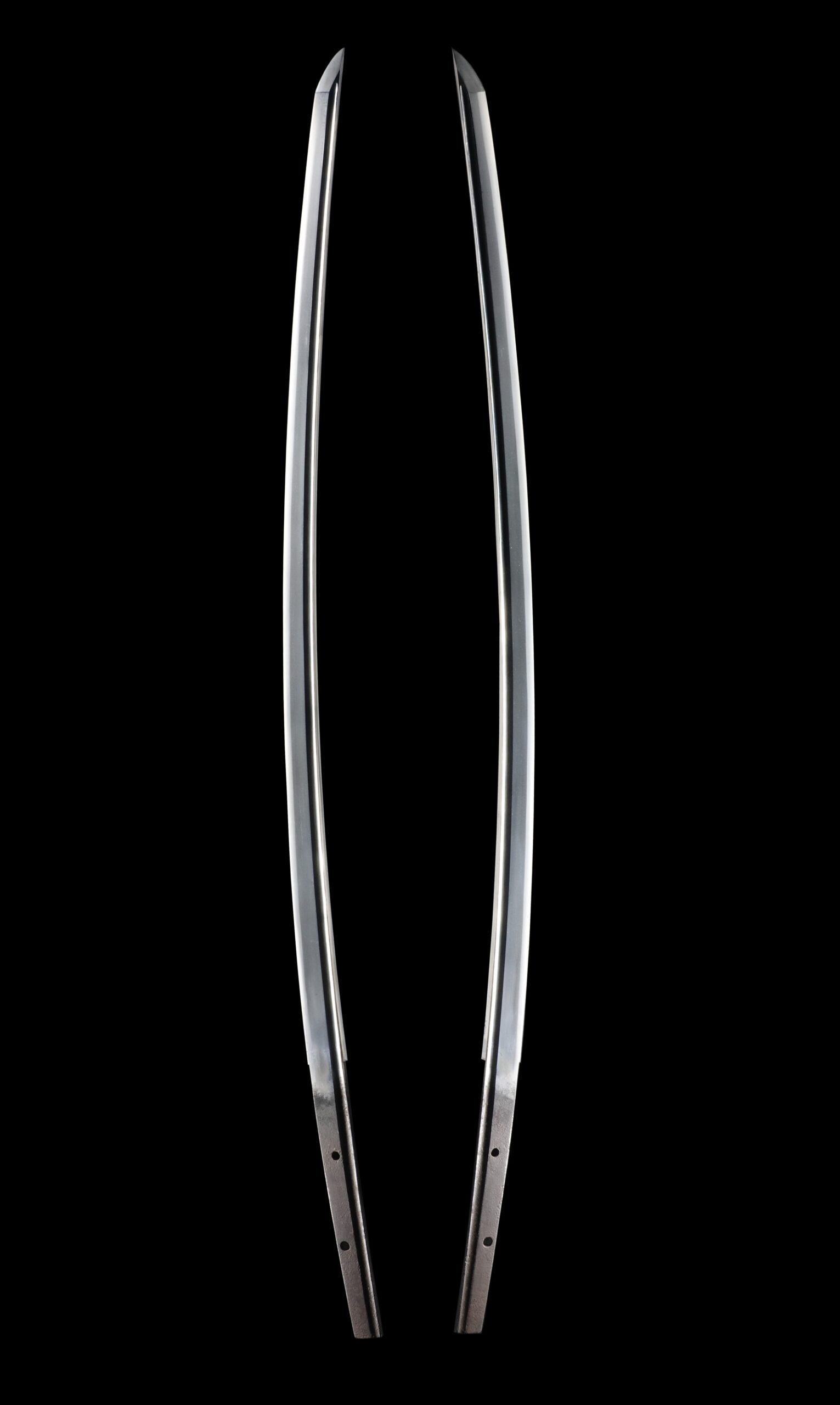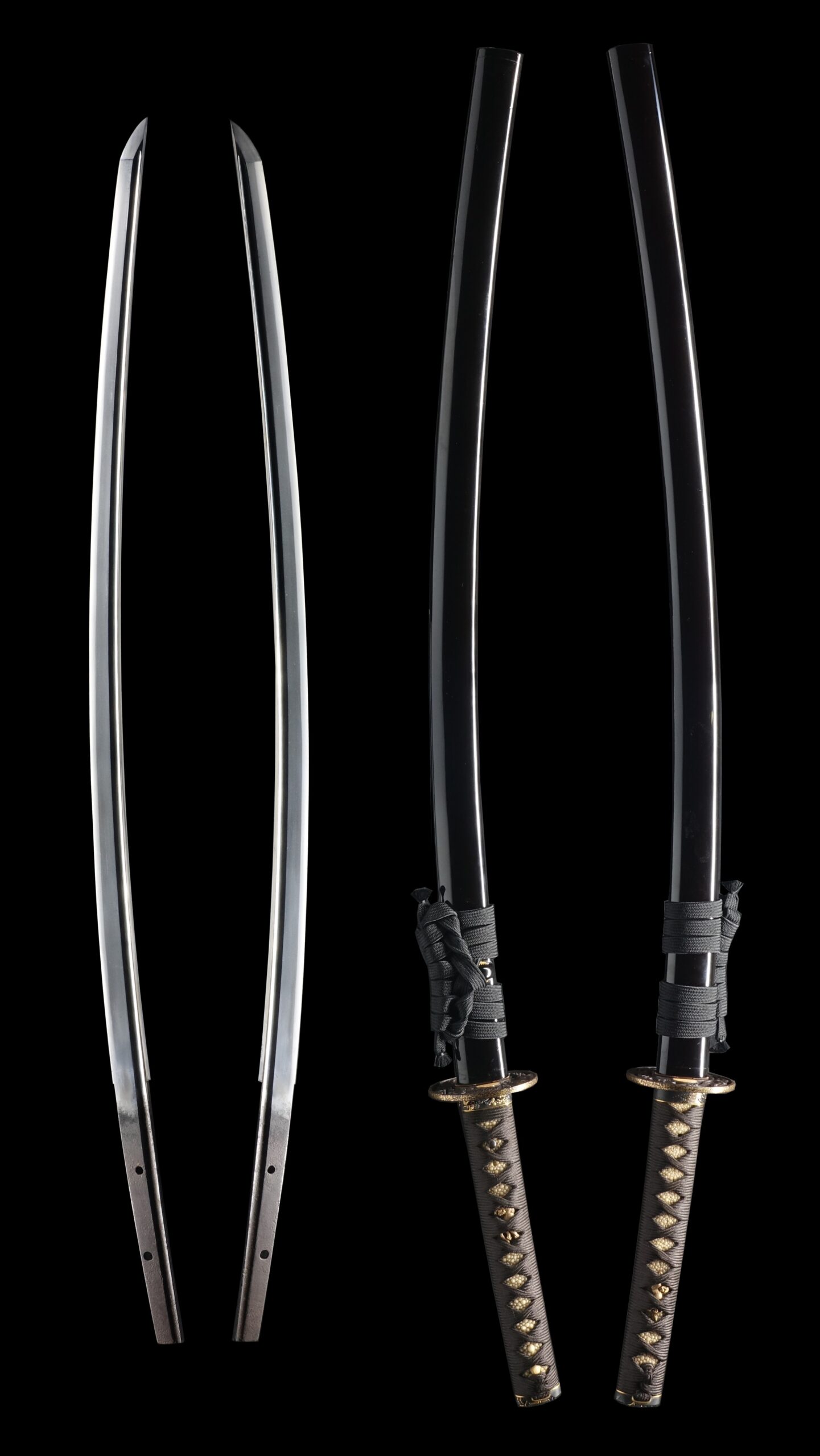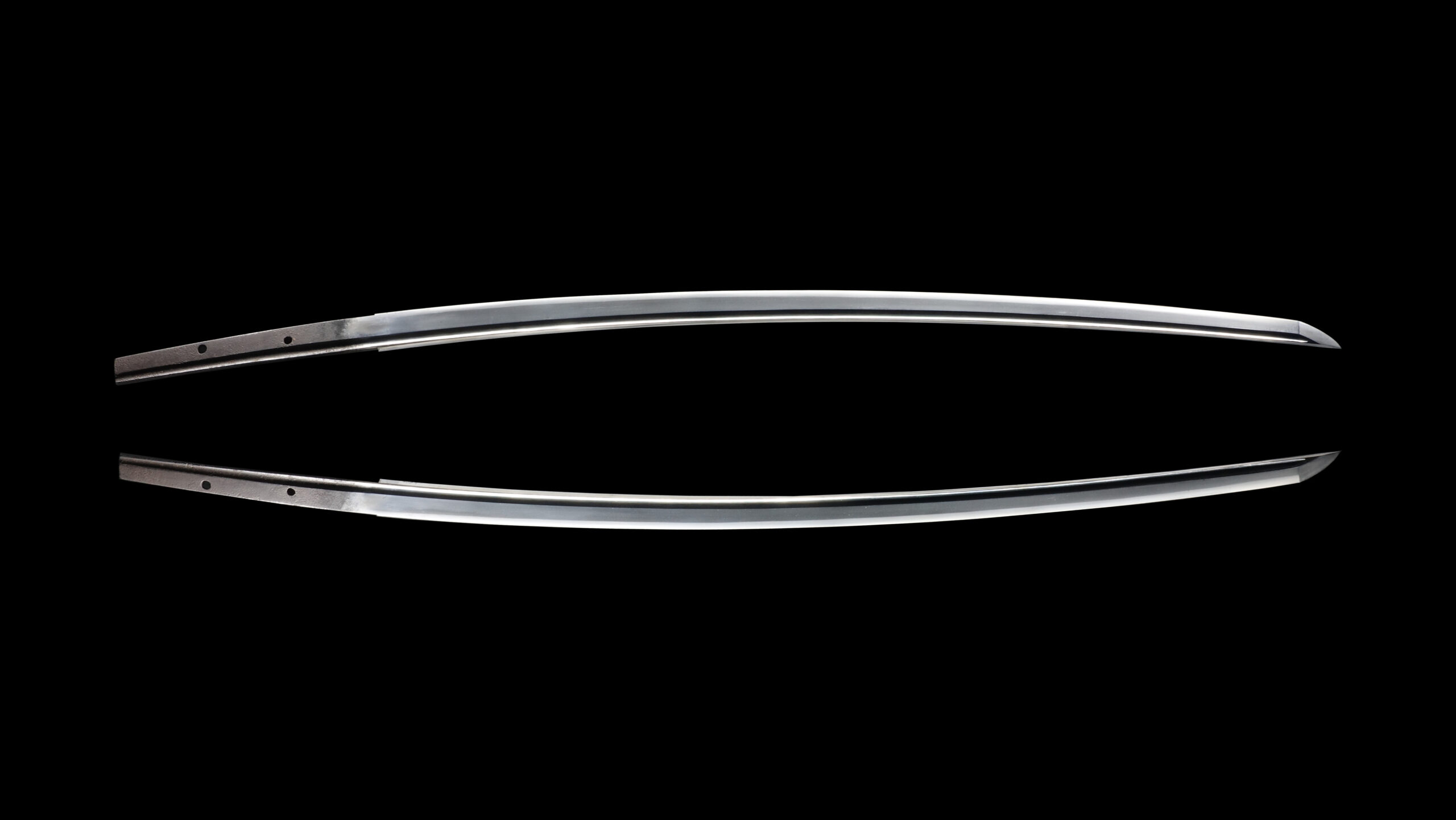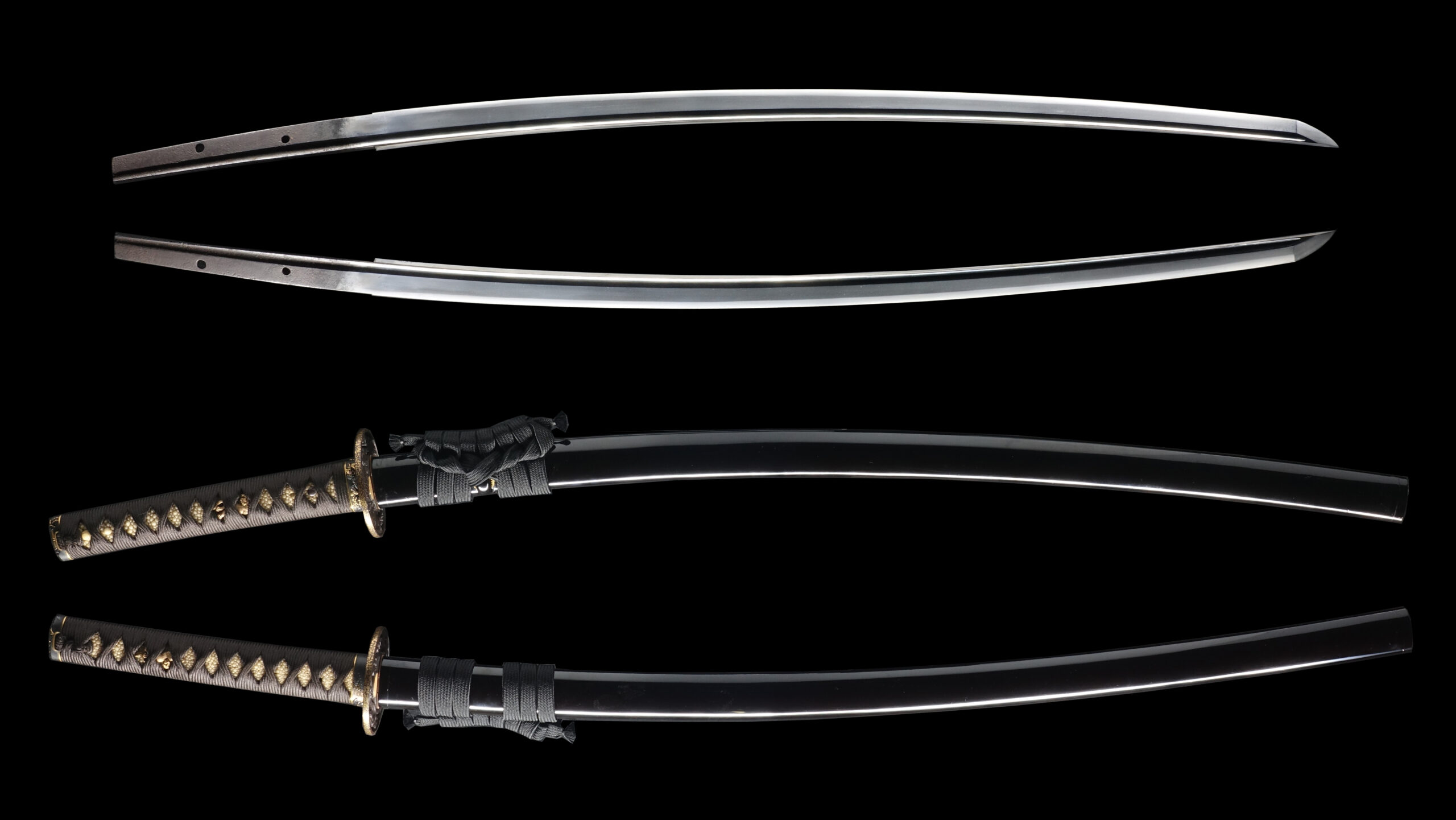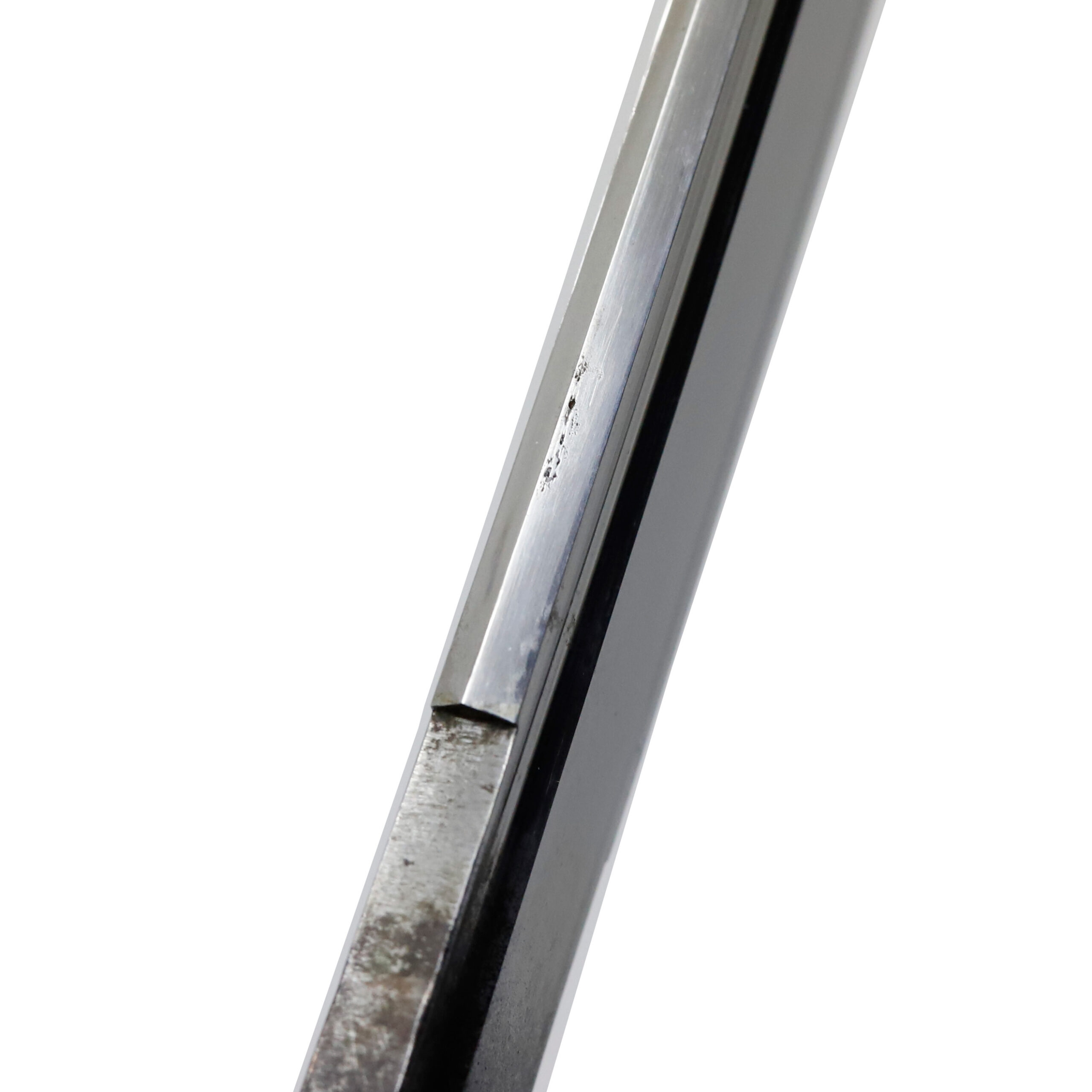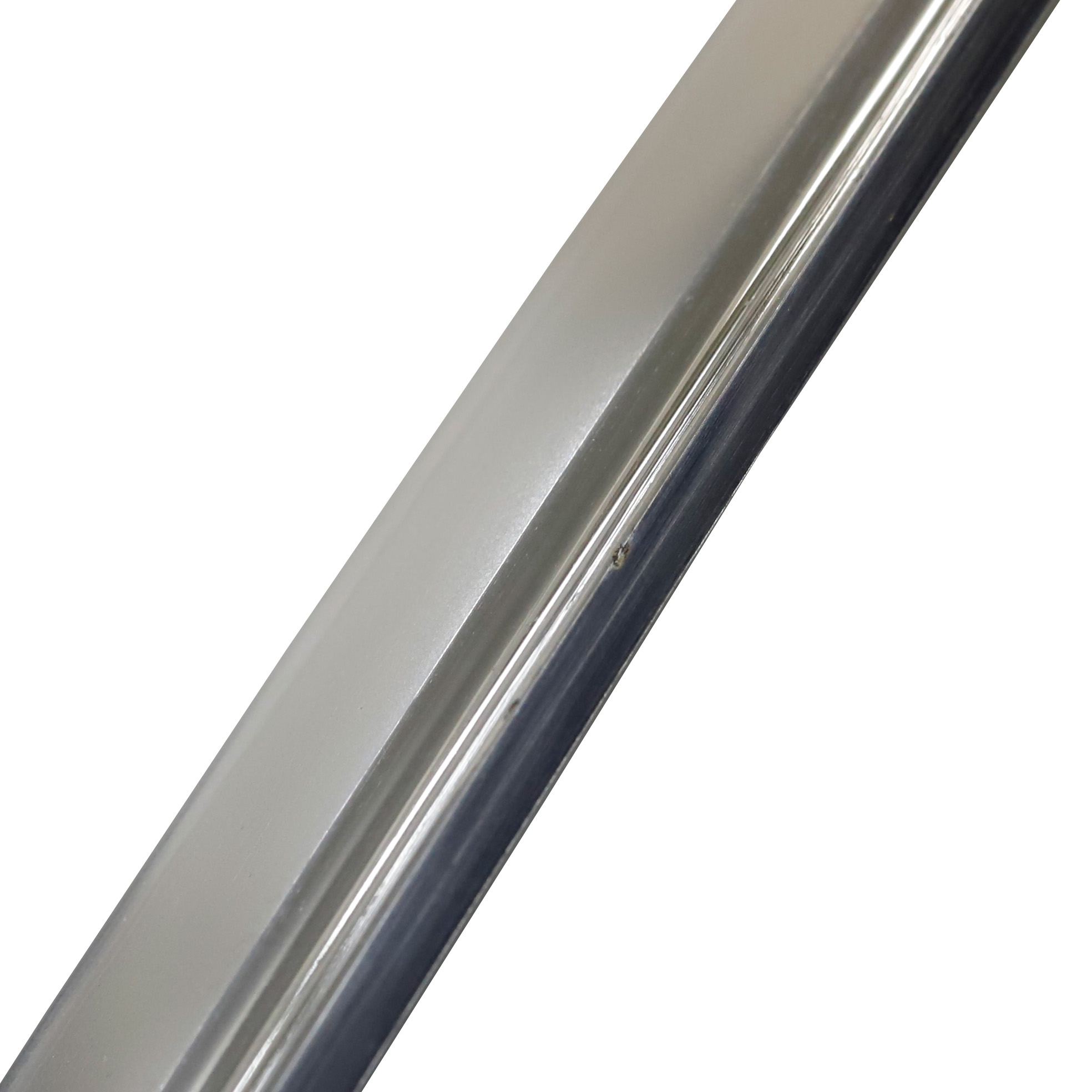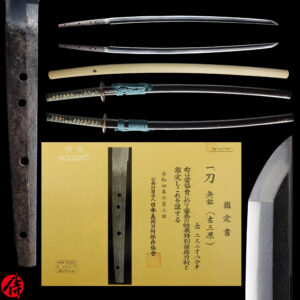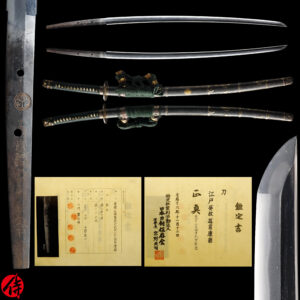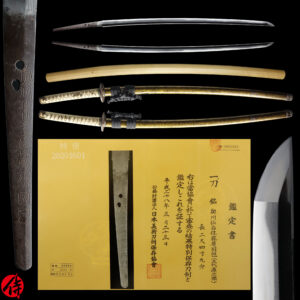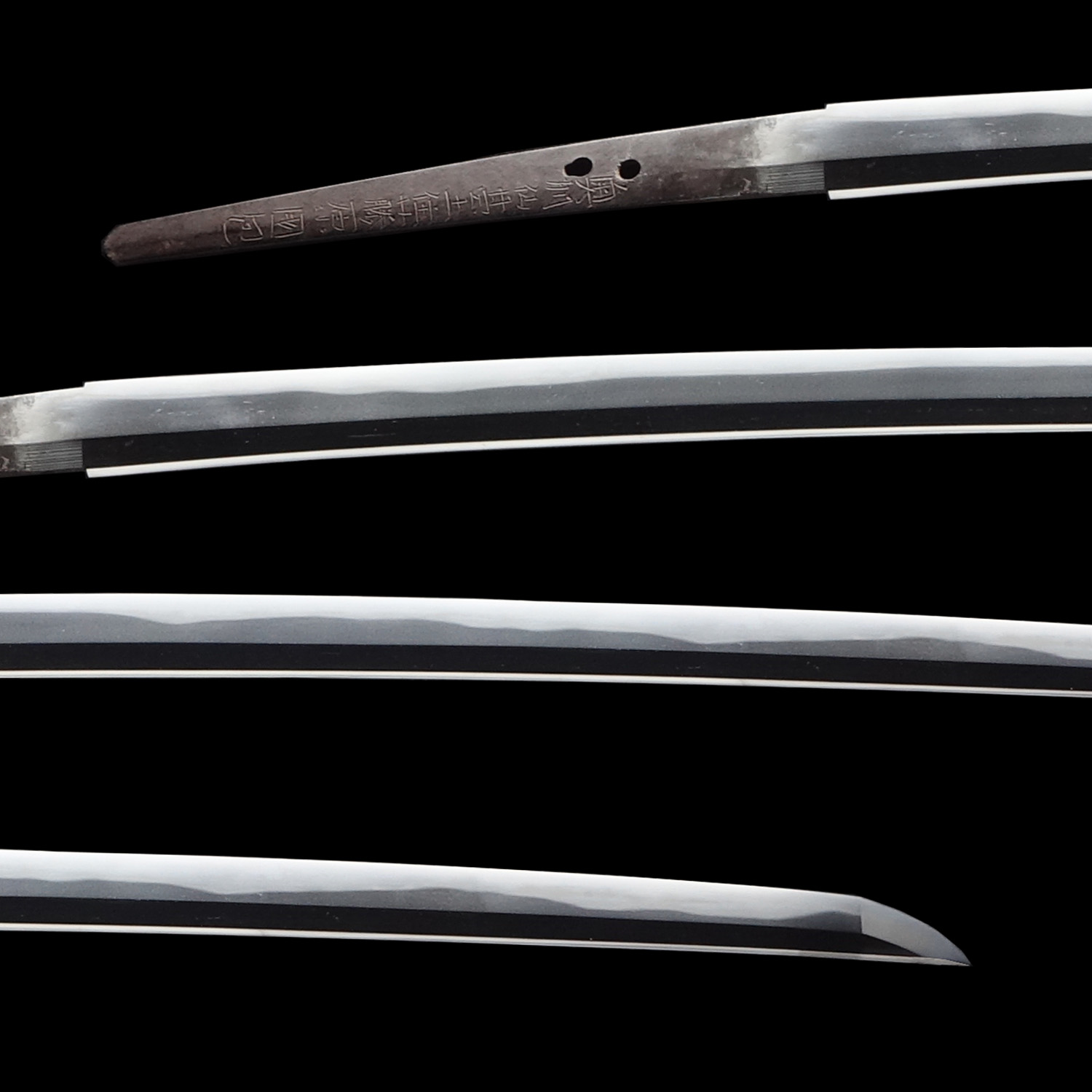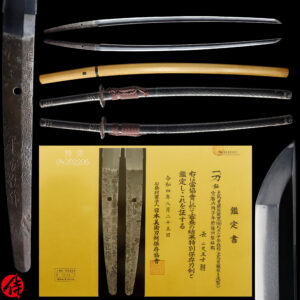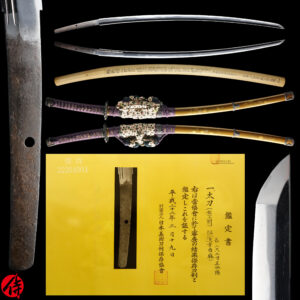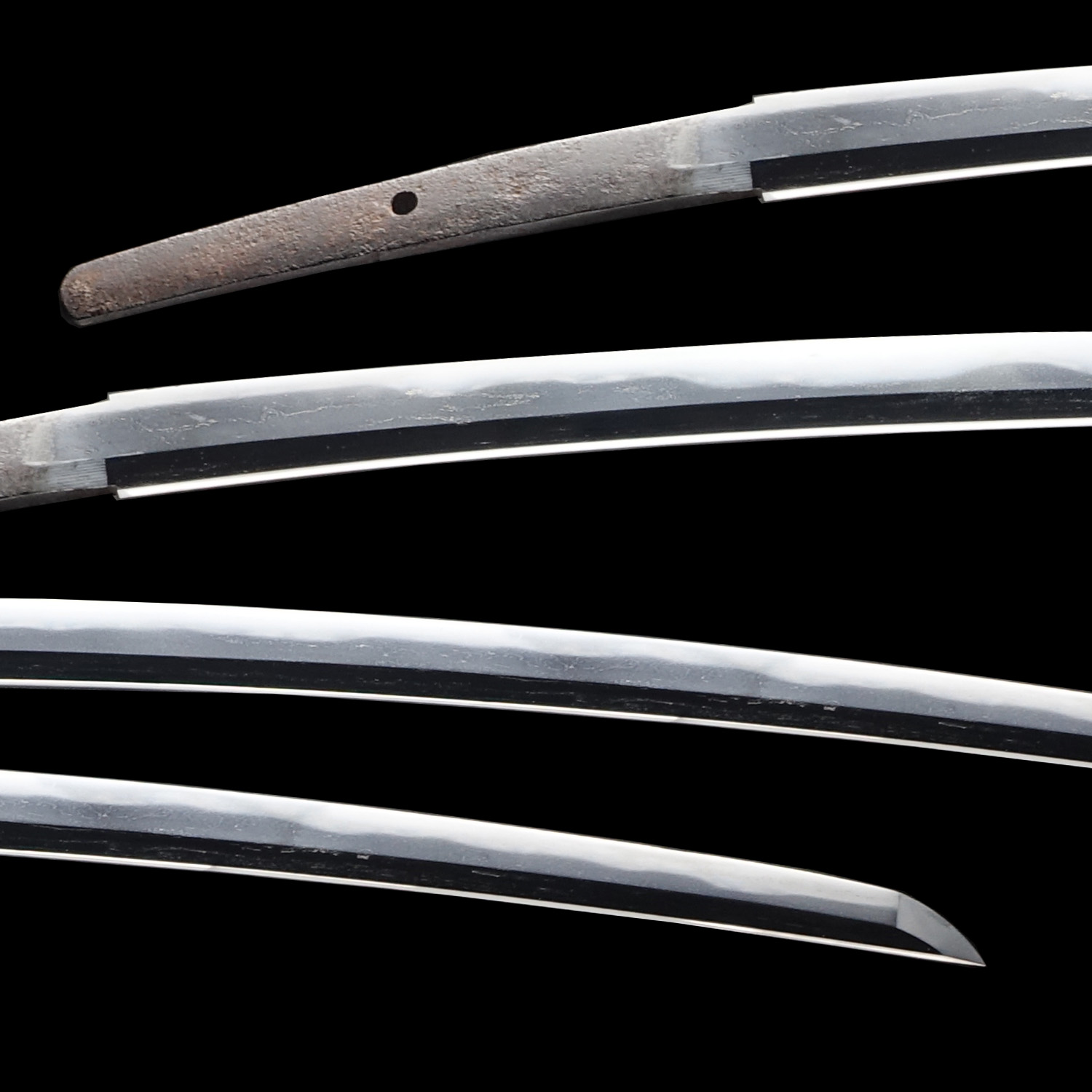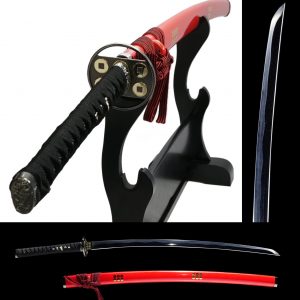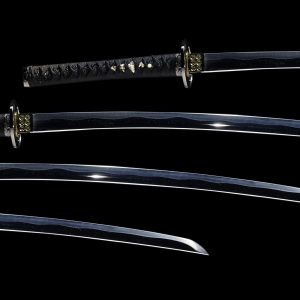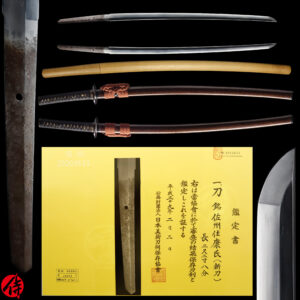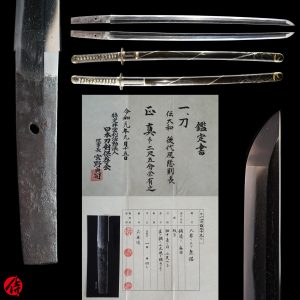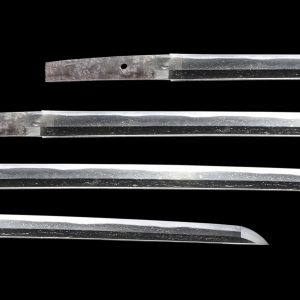Antique Japanese Sword Katana Katana Attributed to Hosho Sadayoshi with NTHK Kanteisho for the blade and NBTHK Hozon for the Koshirae
【Description】
Summary
This blade is attributed to Yamato Hosho Sadayoshi (大和保昌貞吉) in Gen-O era (1319-1321: Late Kamakura period). Yamato is the name of the province located in today’s Nara prefecture. Hosho is the school that flourished during the late Kamakura-early Muromachi period (early14th-early 15th century).
Hosho school was founded by Sadamune (定宗) in the early 14th century in Yamato province (Today’s Nara prefecture). The prominent swordsmiths who belonged to this school were Sadayoshi(貞吉), Sadakiyo(貞清), and Sadaoki(貞興). The Hosho school was famous for creating blades with *Masame Hada, one kind of steel surface pattern that appeared on the Japanese sword.
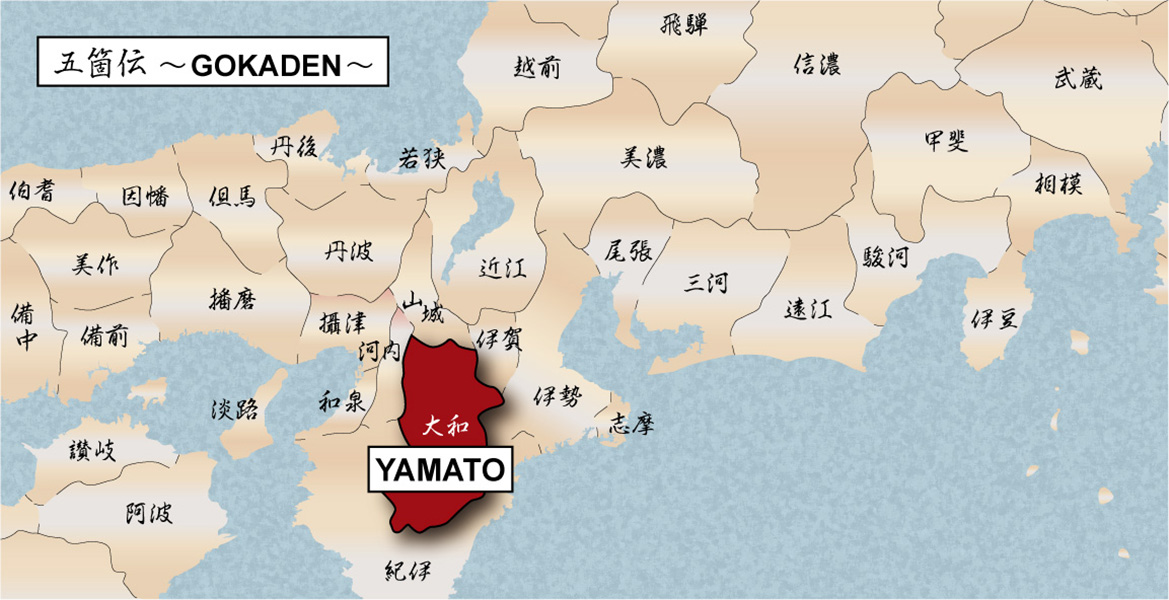
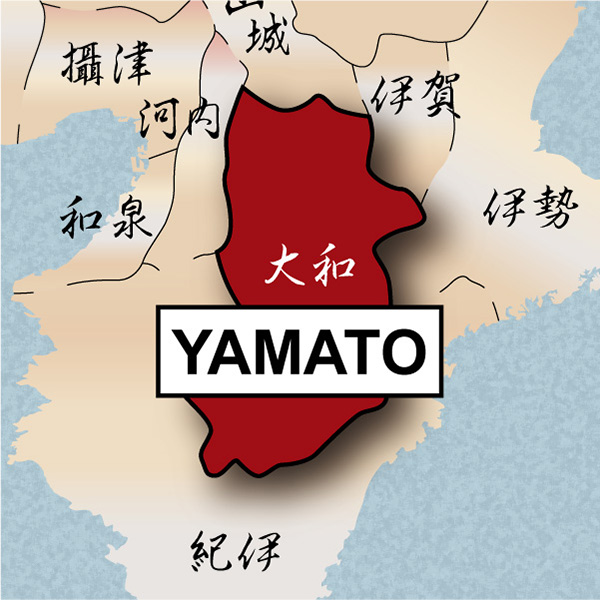
There were five prestigious schools, including Hosho school, during the Kamakura-early Muromachi period in Yamato province. They are called Yamato Goha(大和五派); Senjyuin(千手院), Shikkake (尻懸), Taima(当麻), Hosho(保昌) and Tegai(手掻) school. They served politically powerful monks and temples in Nara, such as Todaiji temples. They were initially forging swords for military monks who became powerful due to the government’s policy back then.
Monks needed many weapons as there were many political rivalries between influential temples. They required strong weapons like swords to protect themselves. During this time, Hosho school or other Yamato sword schools met the requests from monks. They also forged blades for Samurai during their heyday.
Yamato Den
The swords forged in Yamato regions are famous for their beautiful Jigane, steel surface, and straight tempering line (Suguha). And, they invented the particular sword-forging tradition called YAMATO DEN. This blade has a beautiful Jigane with a Suguha tempering line, which shows an outstanding characteristic of the Yamato sword. The overall condition is excellent. Based on the shape of Nakago(Tang), it was shortened in the past. We assume its original length was much longer than it is now.
Masame Hada
Masame (柾目) means straight grain in Japanese, which is often seen in the work of Hosho school. Masame Hada is the Japanese sword terminology for the Hada (steel surface pattern of the Japanese sword) that looks like straight grain when one cuts a tree in half.And it usually is combined with Itame Hada, another grain pattern that looks like wood-grain seen in the Japanese sword.
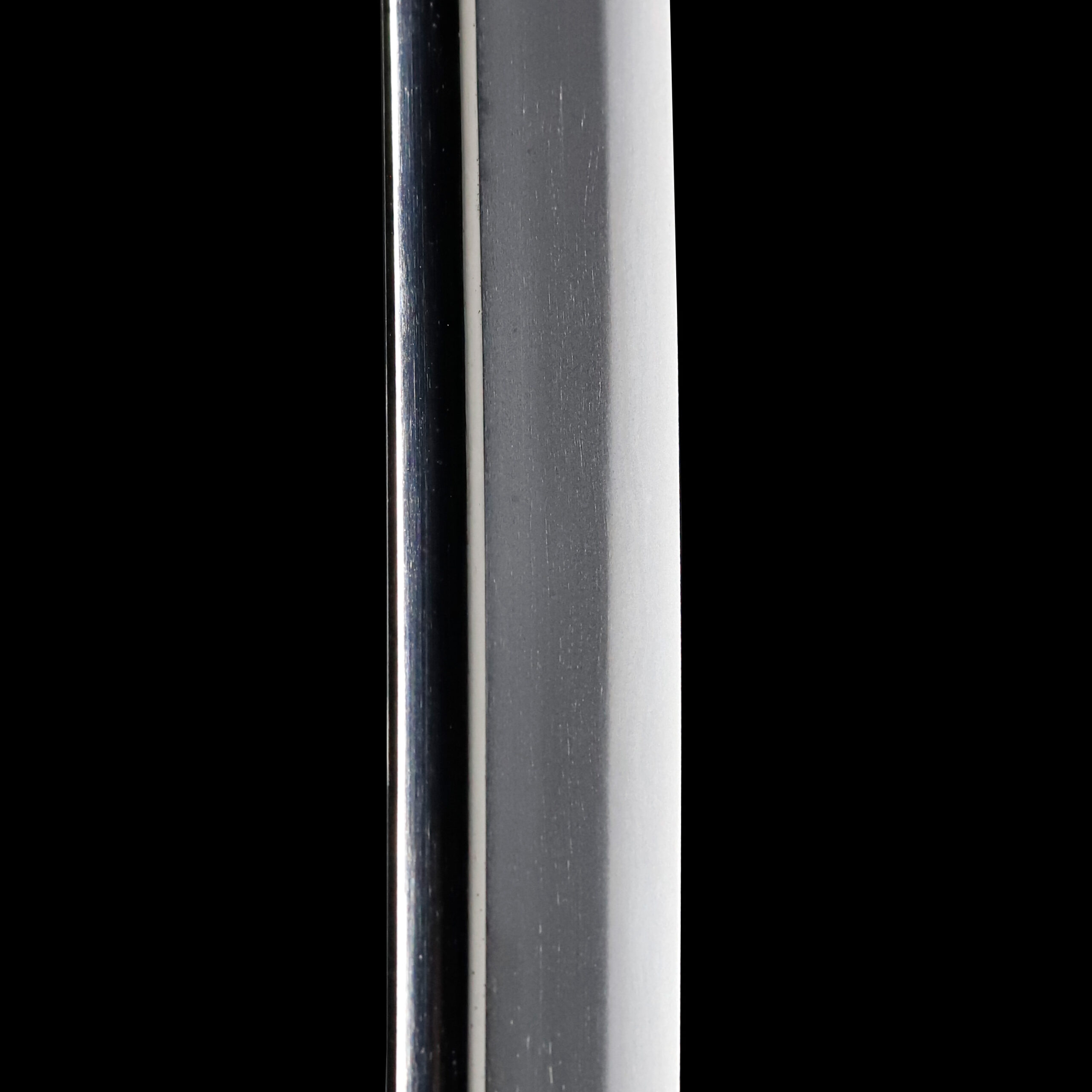
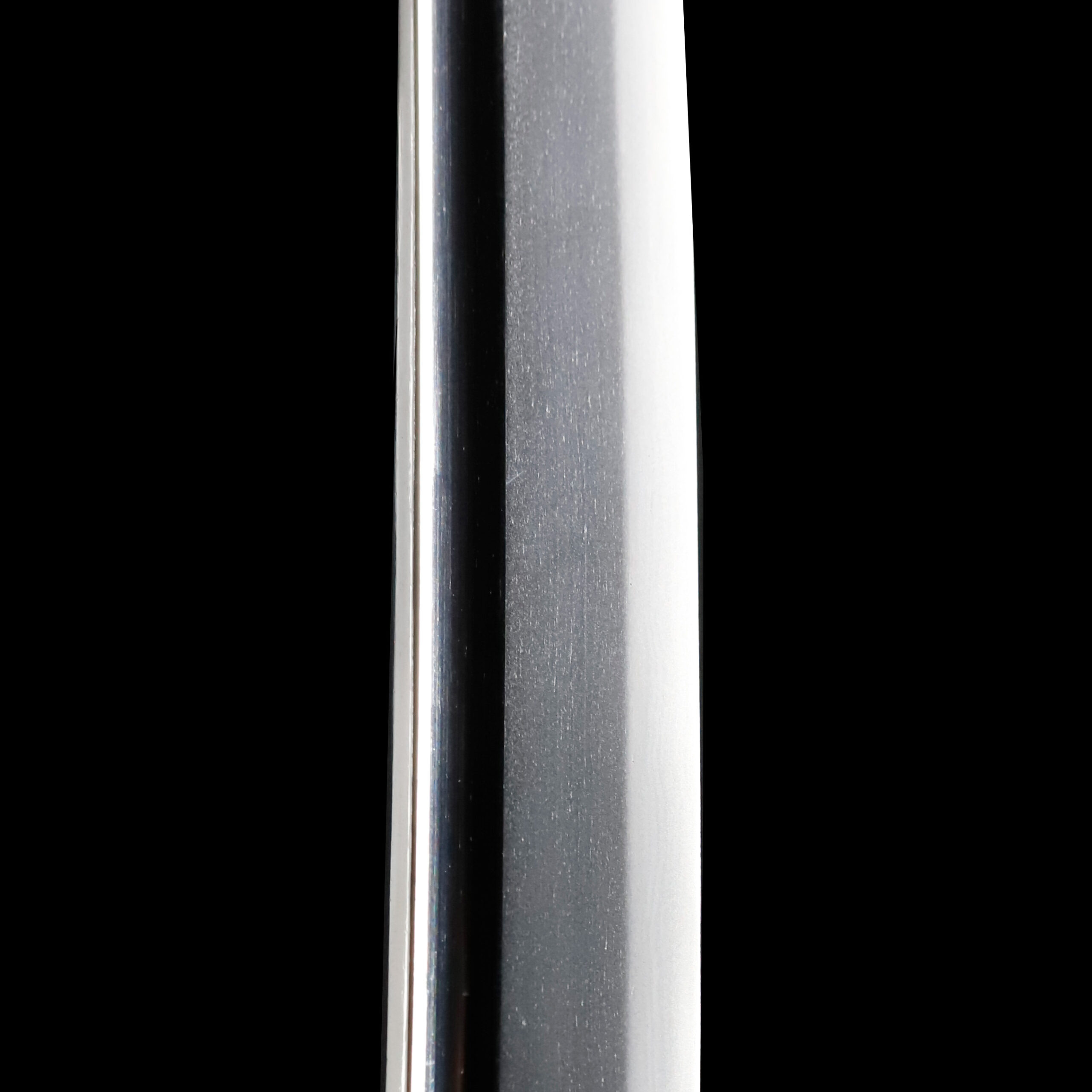
*Please keep in mind that there are a couple of minor Kitae Kizu on the Mune (the backbone of the blade). Please check the listed photos. If you like to see more detailed condition, please feel free to contact us.
【 Blade】
Cutting Edge Length(Nagasa): 68.6 cm (27.0 inches)
Curvature(Sori):2.12 cm ( 0.83 inches)

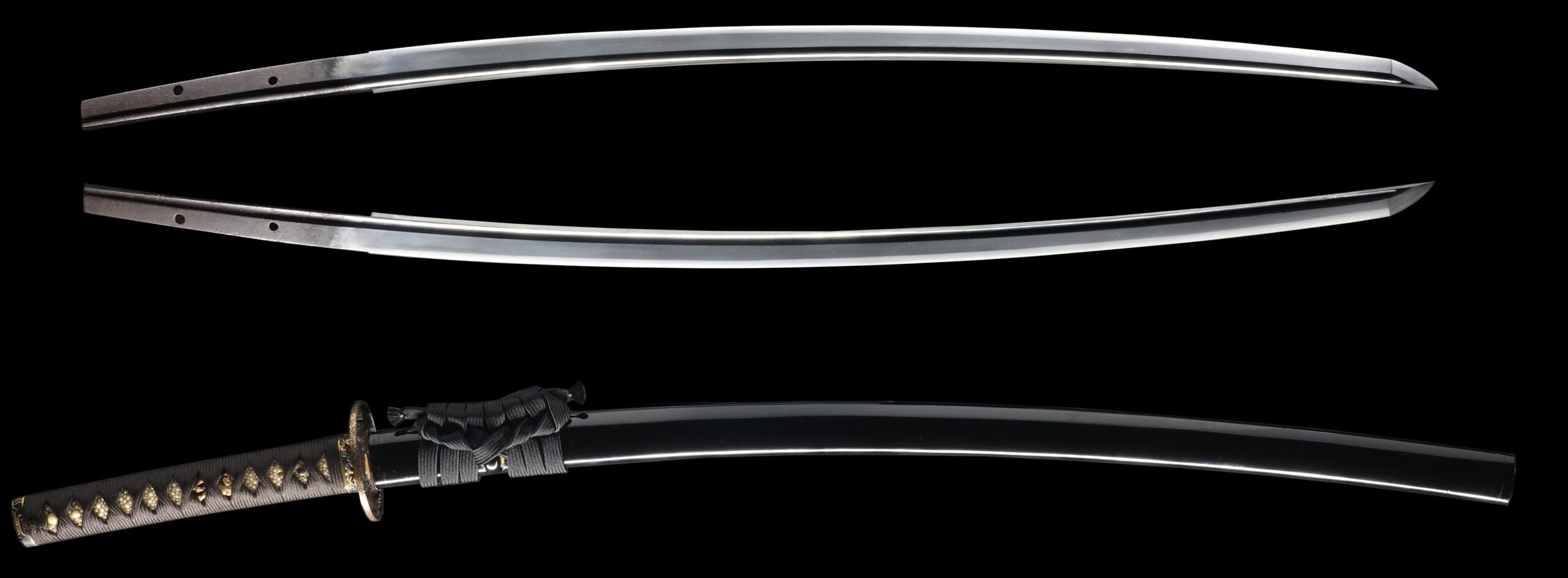
Hamon:
The crystalline structure which forms along the cutting edge of a blade as a result of the hardening process
Jimon(Jihada):
visible steel surface pattern created by folding and hammering during forging process


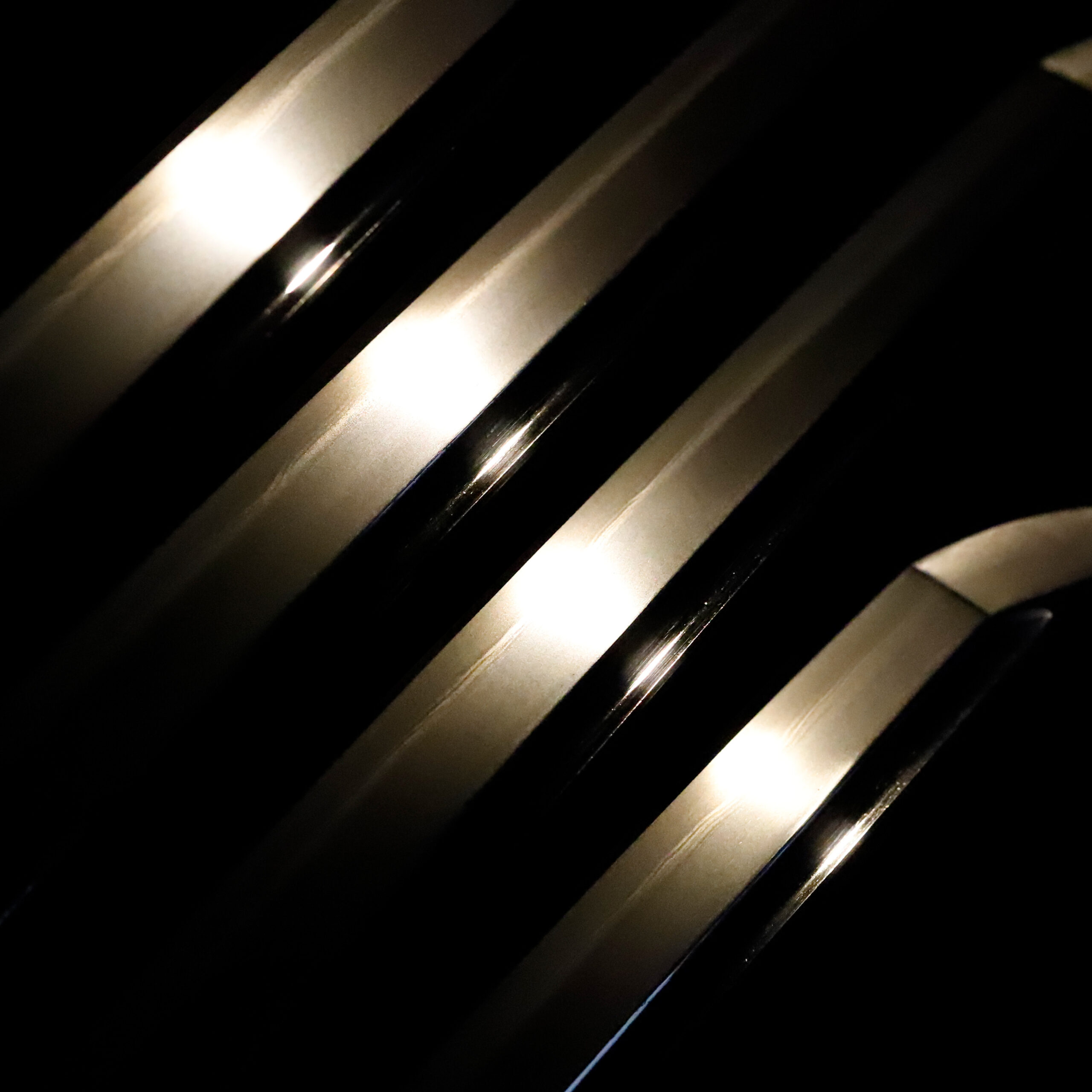
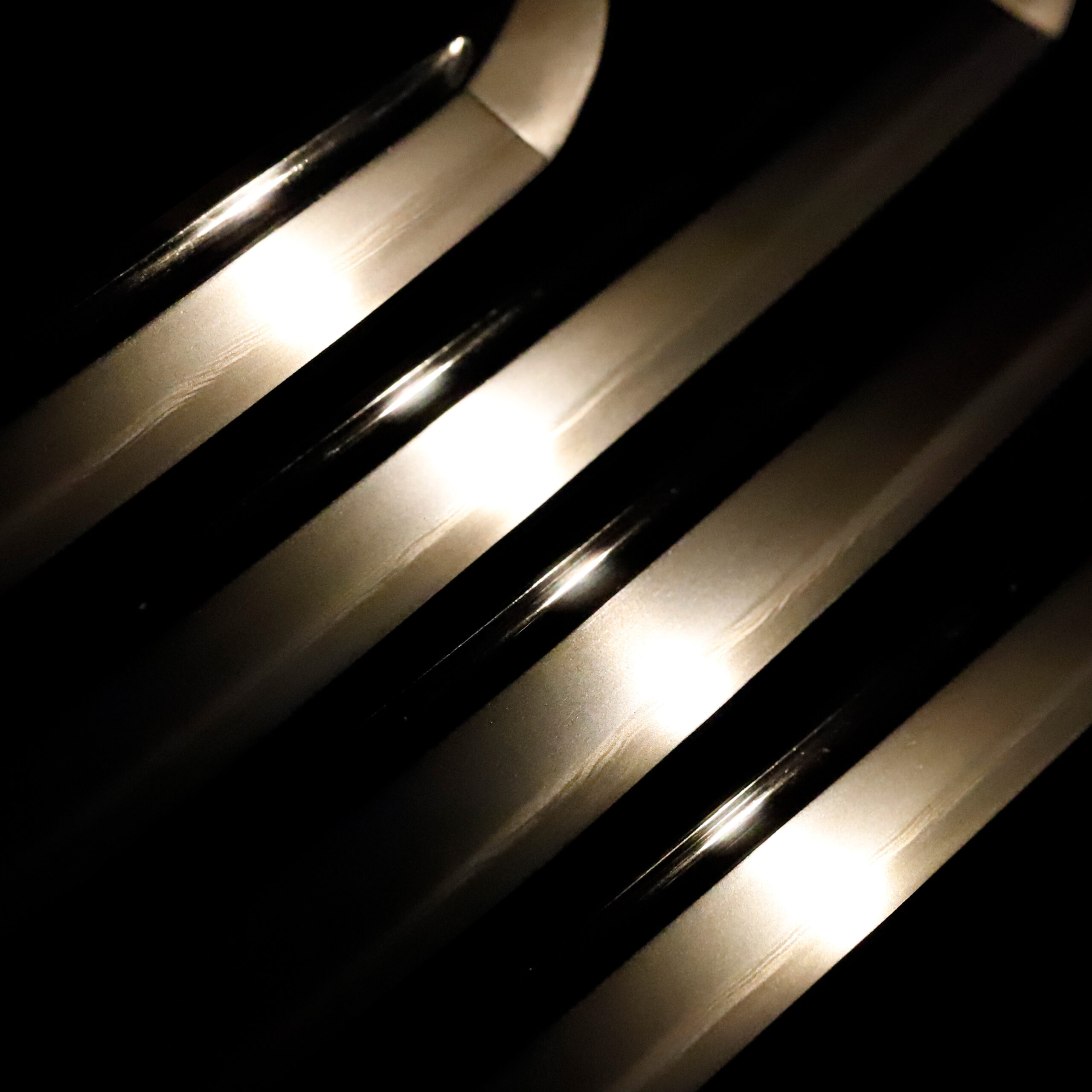
Nakago:Nakago is the tang of the Japanese sword.
Japanese swordsmiths left the black rust on the tang because it prevents red rust while the tang is in its handle. And the discoloration of the tang was created over time, and it is a great indicator for a Japanese sword specialist to estimate when the sword was forged.
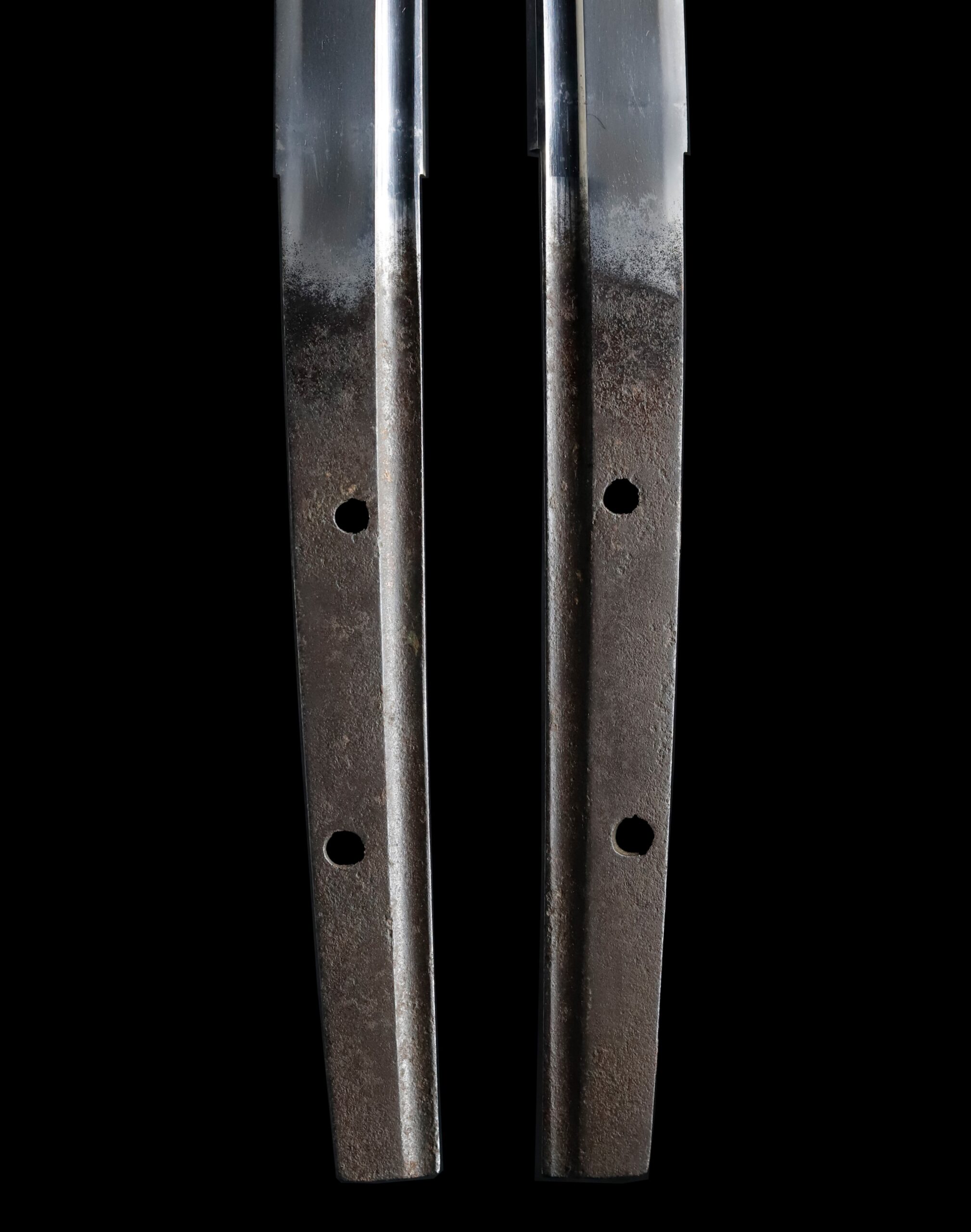
Koshirae: Koshirae is the mounting of the Japanese sword. There are several parts that consist of Koshirae such as Saya(Scabbard), Tsuka(Handle), Tsuba(Handguard).
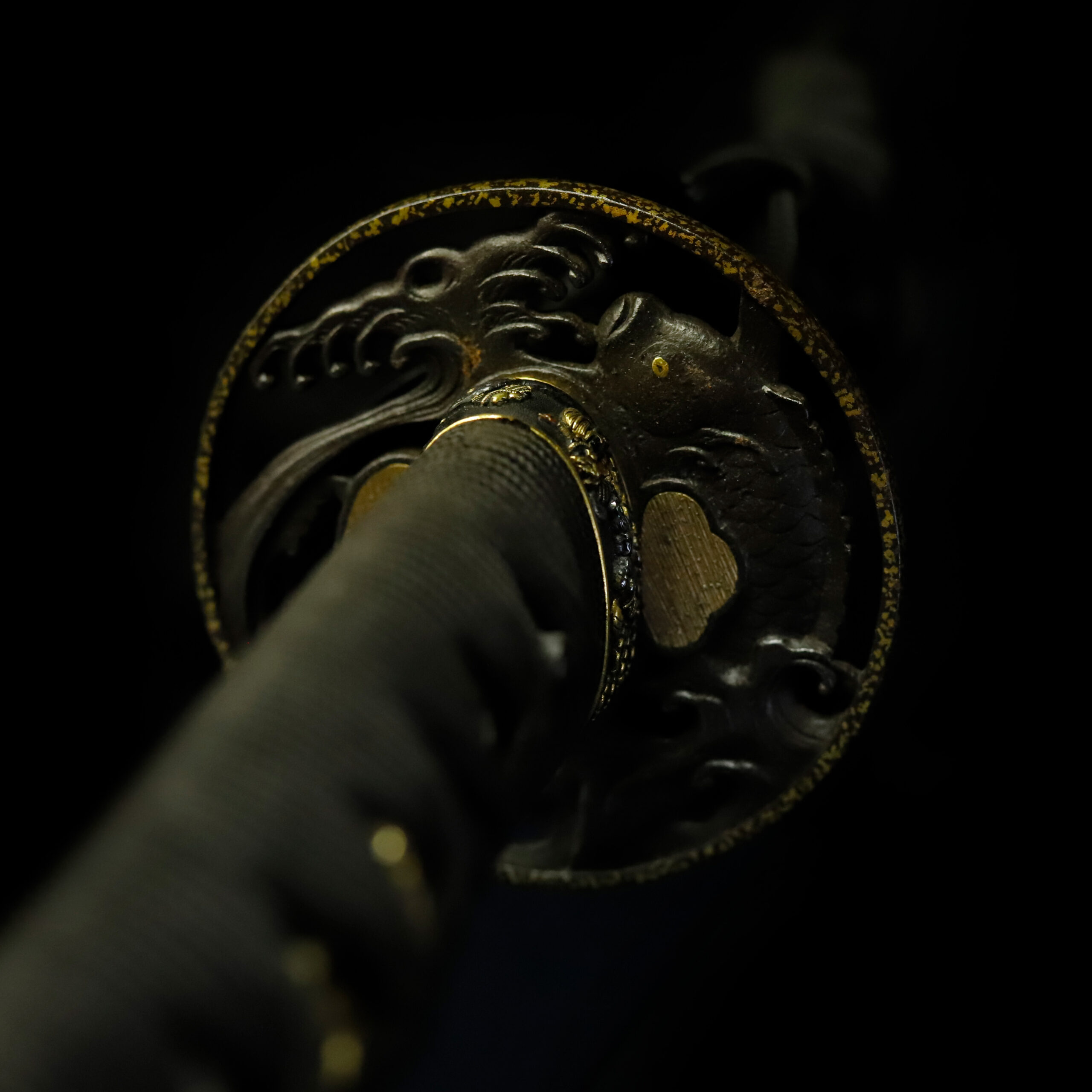
Fuchi-Kashira:A pair of matching sword fittings that cover the upper and bottom parts of its sword hilt.
According to its NBTHK certificate, this Fuchi Kashira depicts a scenery of a battle. You would find the figure of fighting Samurai warriors. They are in ships, plowing through the rough waves and advancing valiantly against the enemy. There is a famous theme that has sometimes been seen in sword mountings as a design: the Genpei Kassen (源平合戦). Although we are unsure if this Fuchi Kashira depicts exactly this battle, here we would like to introduce its synopsis as a possibility and share a famous piece of Samurai history with you.
The Genpei Kassen does not refer to one battle. This is a collective term for the civil wars heated in various parts of the country that continued over six years from 1180 until 1185. It is also called the Jishou Juei-no Ran (治承・寿永の乱). This was the conflict between the Minamoto (源) clan (Genji family) and the Taira (平) clan (Heike family). By the call of Mochihito Ou (以仁王), many Samurai raised armies to overthrow the Taira family. It was the trigger of this protracted conflict. Mochihito Ou was unfortunately beaten by the Taira family and passed away in 1180. However, after that, Minamoto family side Samurai defeated the Taira side armies one after another. Finally, the Minamoto side won the battle and overthrew the Taira clan in 1185 at Dan-no Ura (壇ノ浦). It was the final battle of the Genpei Kassen, which led to the destruction of the Taira clan, who reached the height of glory.
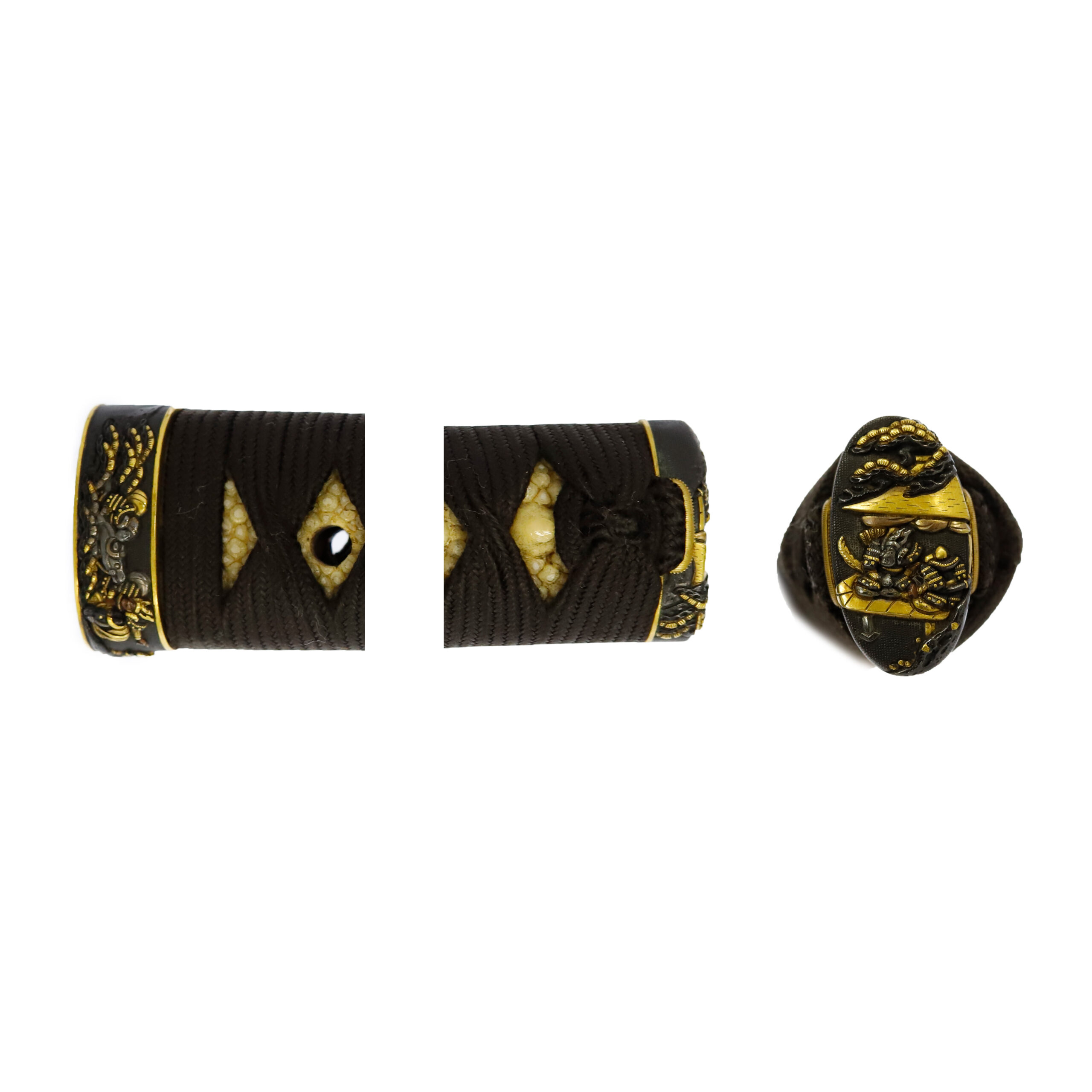
Tsuka and Menuki:Tsuka is the handle of the Japanese sword and Menuki is its decoration.
Fierce tiger is designed on this Menuki. The tiger is a brave animal. A theory says people considered the tiger pattern would protect people from evil spirits. Therefore, its pattern has been treated as a talisman. The tiger design has also been regarded as the symbol of life activity when “tiger” is written by a Japanese Kanji character (漢字, a kind of Japanese letter) based on its meaning. It is said people wished boys’ healthy growth by using the tiger pattern.
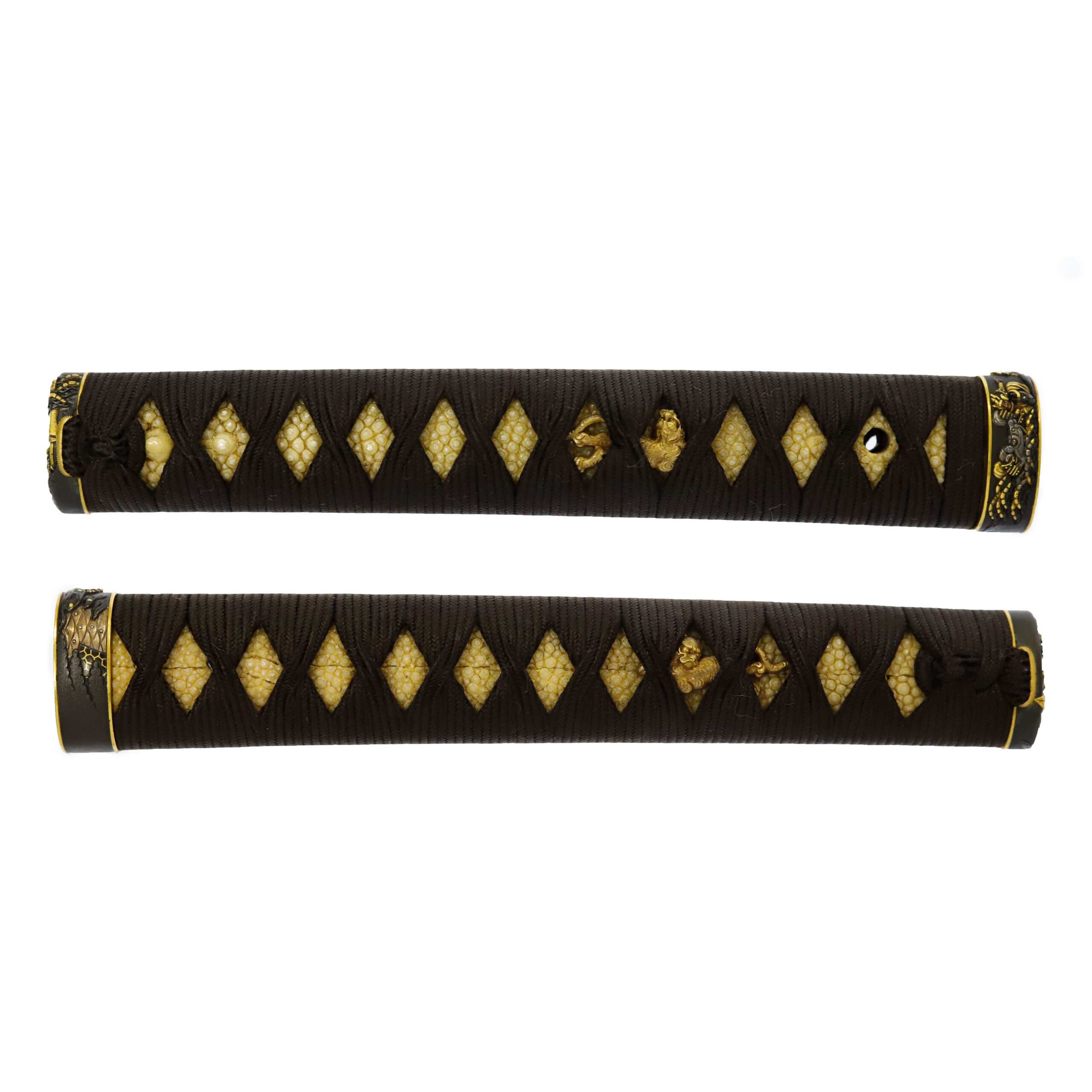
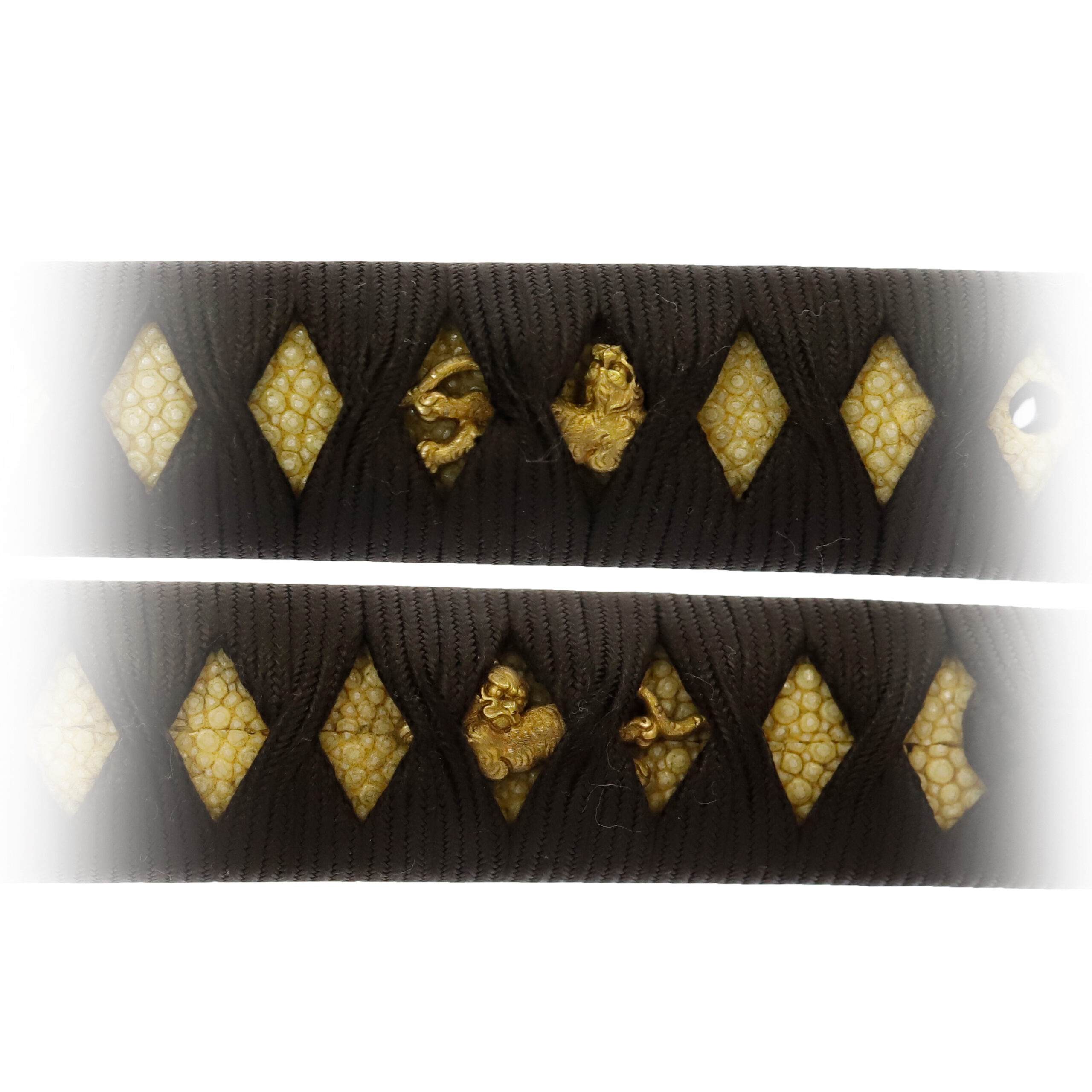
Tsuba and Habaki:Tsuba is the handguard for the Japanese Sword and Habaki is the equipment to make the blade not touch its scabbard inside. It prevents the blade from getting rusty and chipped.
A fish-like animal and waves are designed for this Tsuba. According to the certificate, this fish is a Koi (鯉, domestic carp). Based on an ancient foreign story, many fish tried to climb the waterfall called the Ryumon (竜門, dragon gate) in the rapid stream of the Yellow River. As a result, only Koi climbed up and became a dragon and ran through the sky. This is the reason why “Koi-no Taki Nobori” (鯉の滝昇り, domestic carp climbing waterfall) became a symbol of success in life. The Ryumon legend is associated with this story. By living confidently and making efforts, people hoped for their children to grow up to become magnificent people. Samurai families then might have used this fish motif wishing their sons to be promoted to high-ranked Samurai.
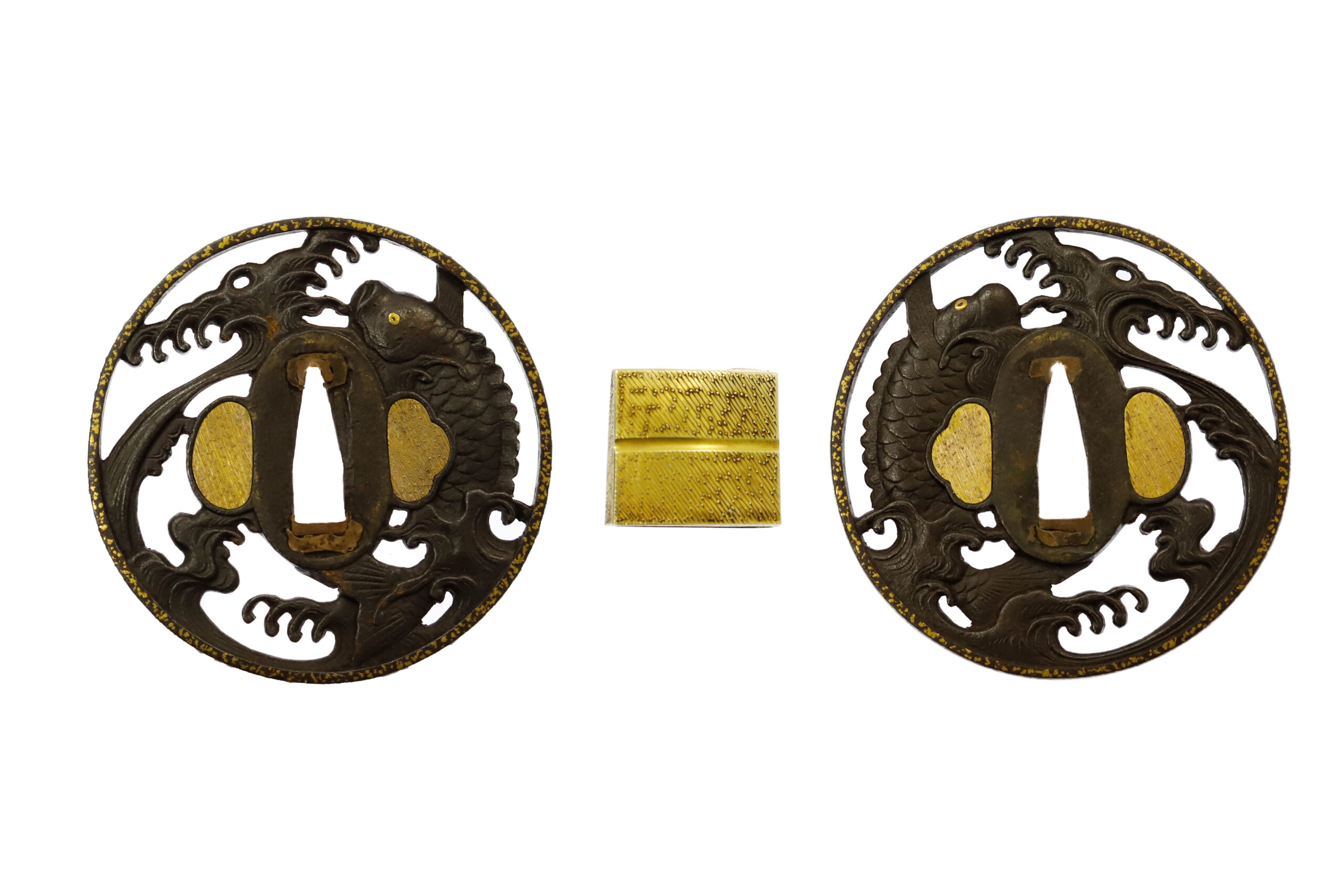
Saya: Saya is the scabbard for the Japanese sword.
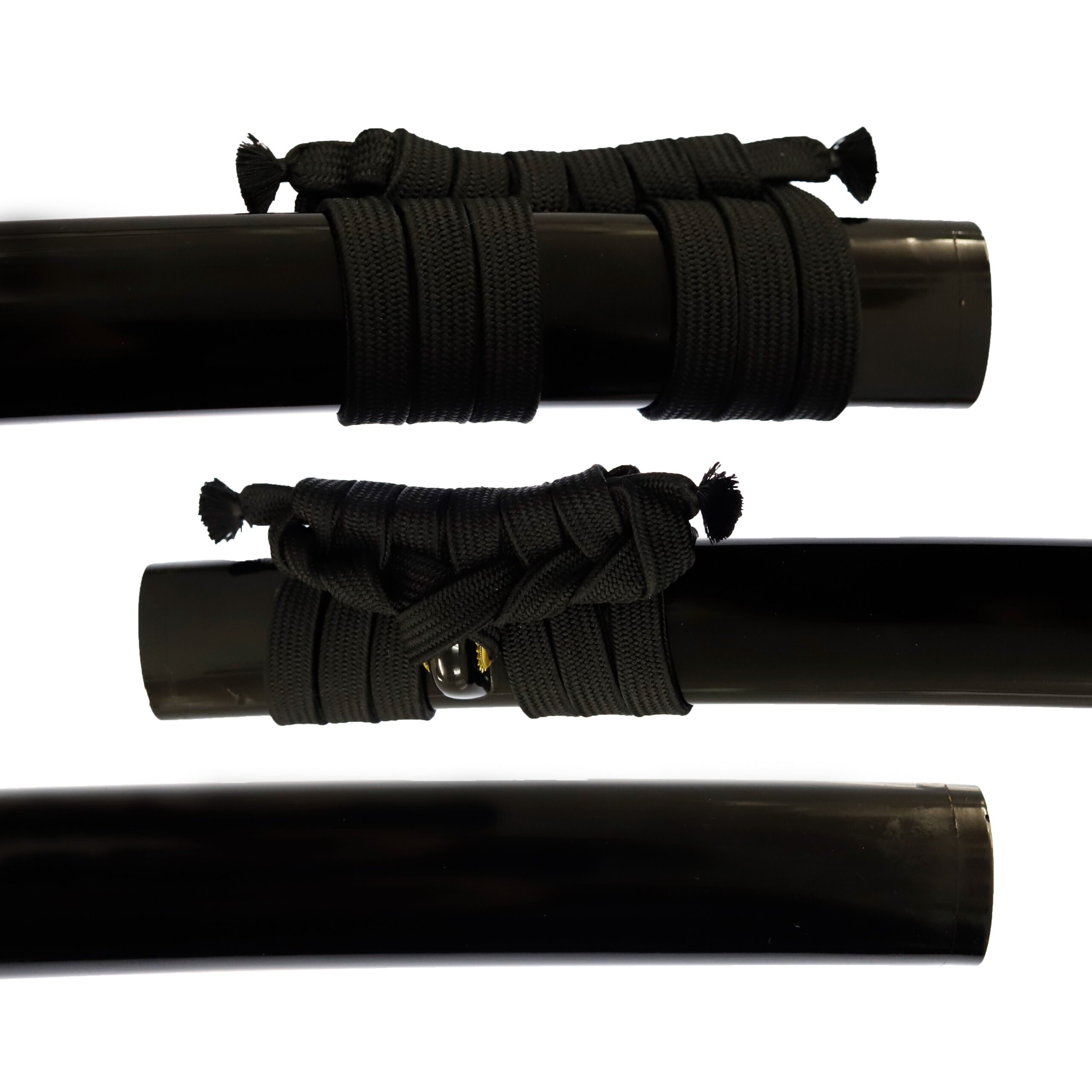
Authentication Paper:NTHK Kanteisho Certificate for the blade
NTHK, also known as NPO Nihon Touken Hozon Kai, is the oldest organization for sword authentication of Japanese swords in modern times. It was established in 1889 during the post-Samurai era. They authenticated the blade on July 26th in the 5th year of Reiwa (2023). The purchaser will receive this original certificate as well. We can also translate what is written into English and make a PDF file for your record if you request.
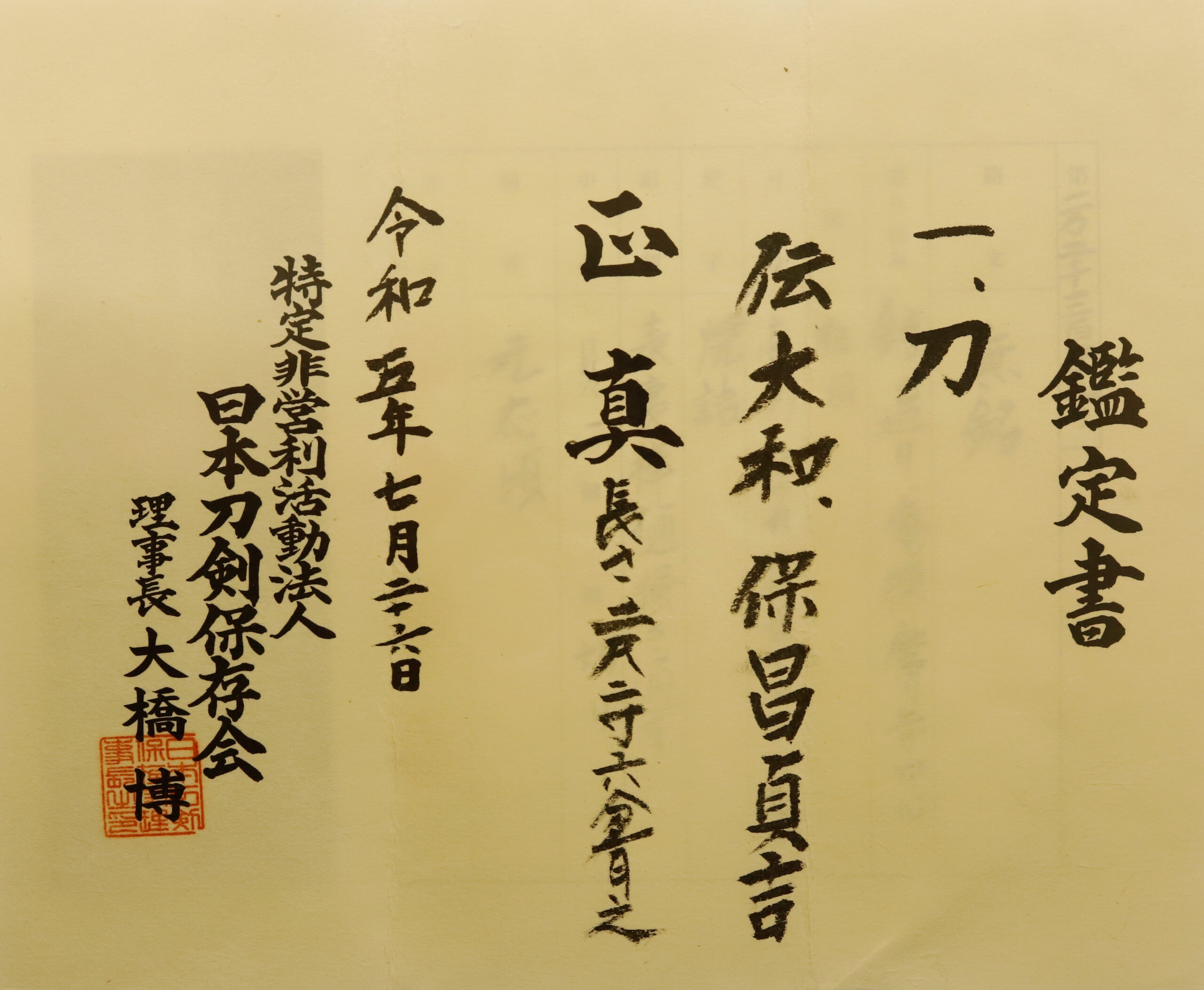
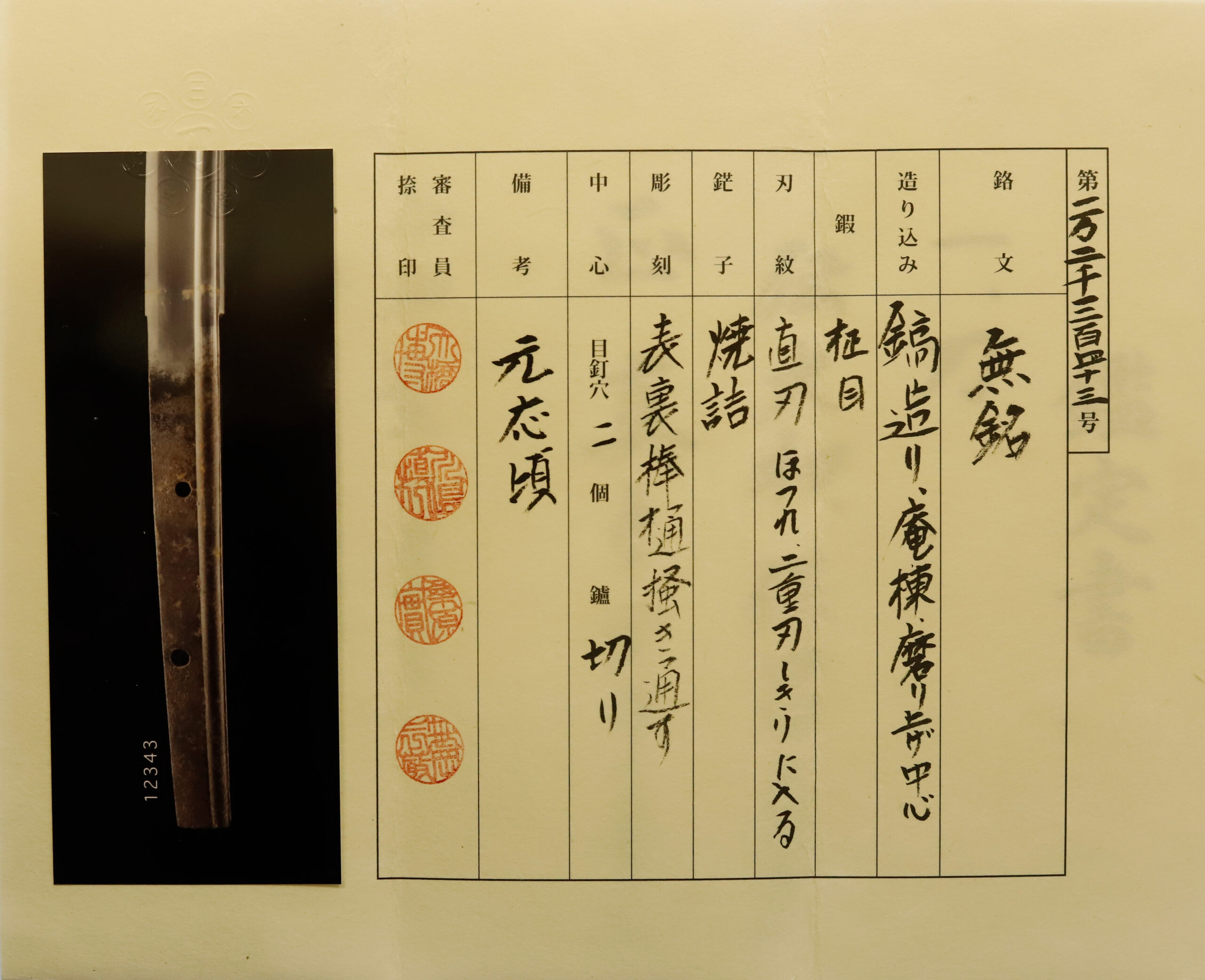
Authentication Paper:NBTHK Hozon Certificate for the Koshirae (No. 4021499)
NBTHK, also known as Nihon Bijutsu Touken Hozon Kyokai (the Society for the Preservation of the Japan Art Sword), is one of the oldest Japanese sword appraising organizations in modern-day Japan. They authenticated the Koshirae on April 4th in the 5th year of Reiwa (2023). They appraised it as Hozon Tosogu, the sword mounting worth preserving for Japanese society. We are expecting to receive its certificate by the end of May. The purchaser will receive this original certificate as well. We can also translate what is written into English and make a PDF file for your record if you request.
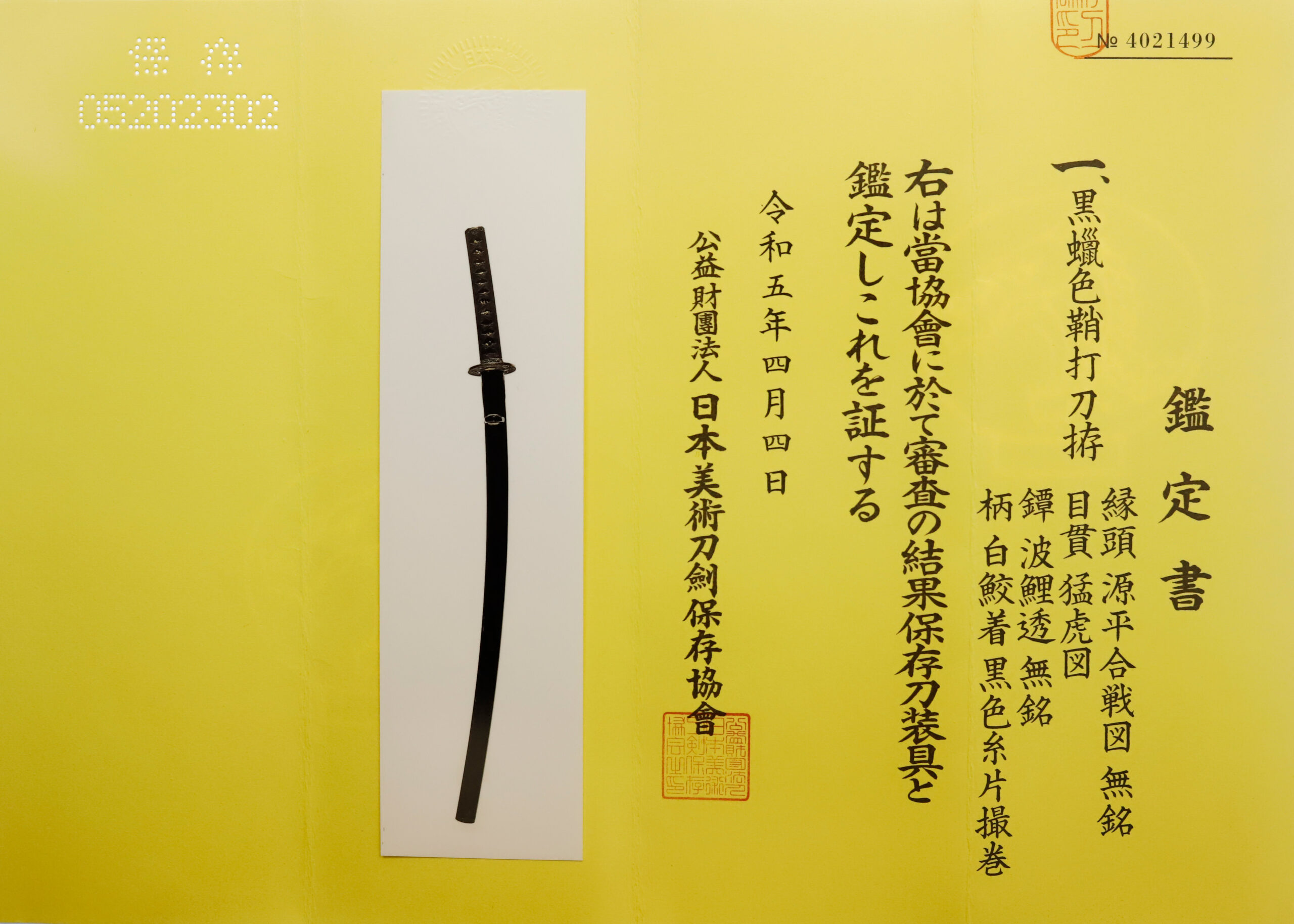
Registration Number : Tokyo 25068
The Board of Education in Tokyo prefecture issued a registration paper for this sword . It is called Jyu Token Rui Torokusho(銃刀剣類登録証). Bunkacho(The Agency for Cultural Affairs) acknowledges a Japanese sword with this paper as a work of art.
The sword needs to be traditionally hand-forged and made of Tamahagane carbon steel to be registered in the system. With this paper, its owner in Japan can legally own an authentic Japanese sword. Based on this registration number, we will apply for its export permit.
This paper will need to be returned to the board of education when the sword is being shipped abroad, but you can receive a copy of it. An English translation of this registration paper is available on request.
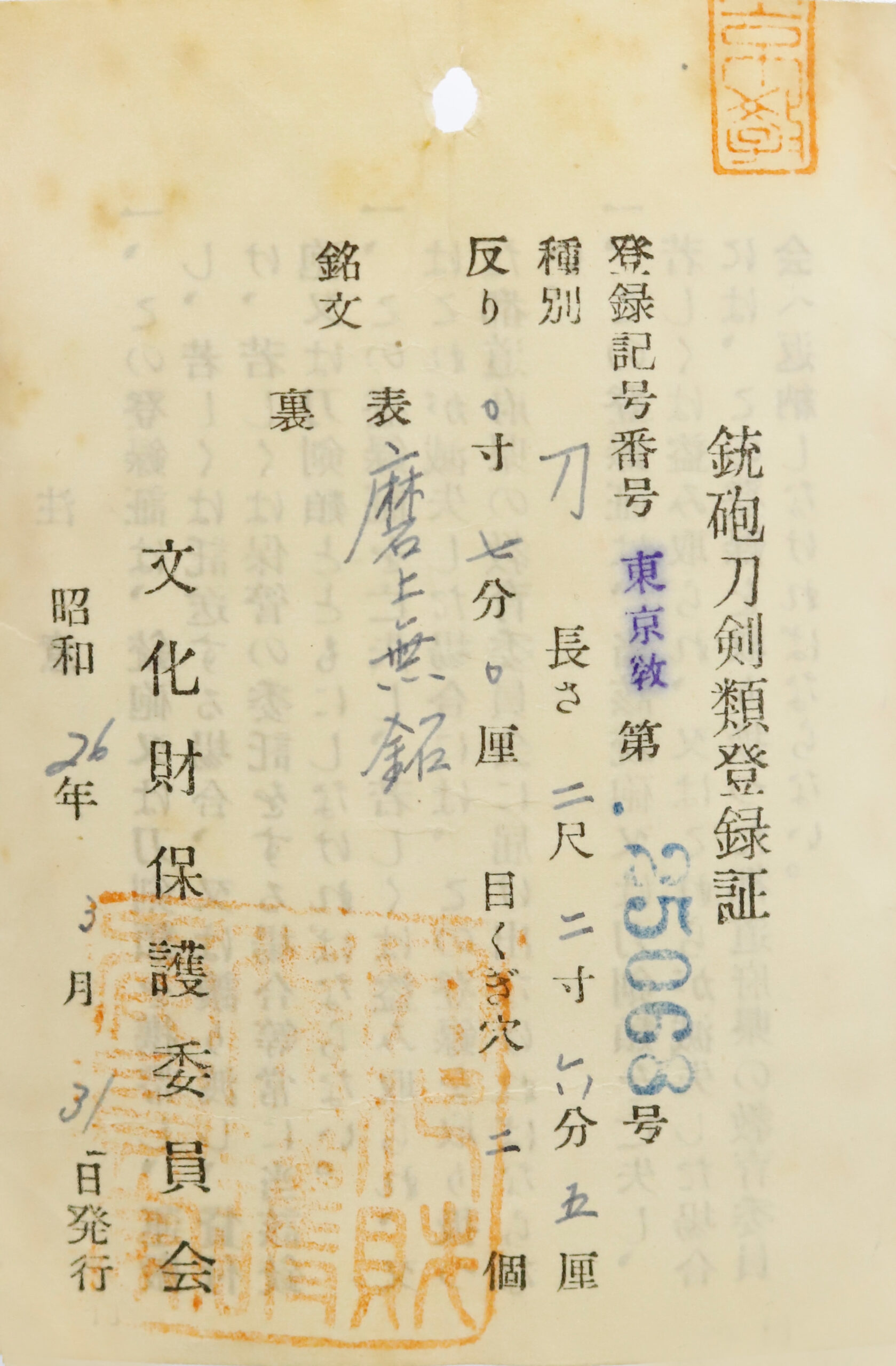
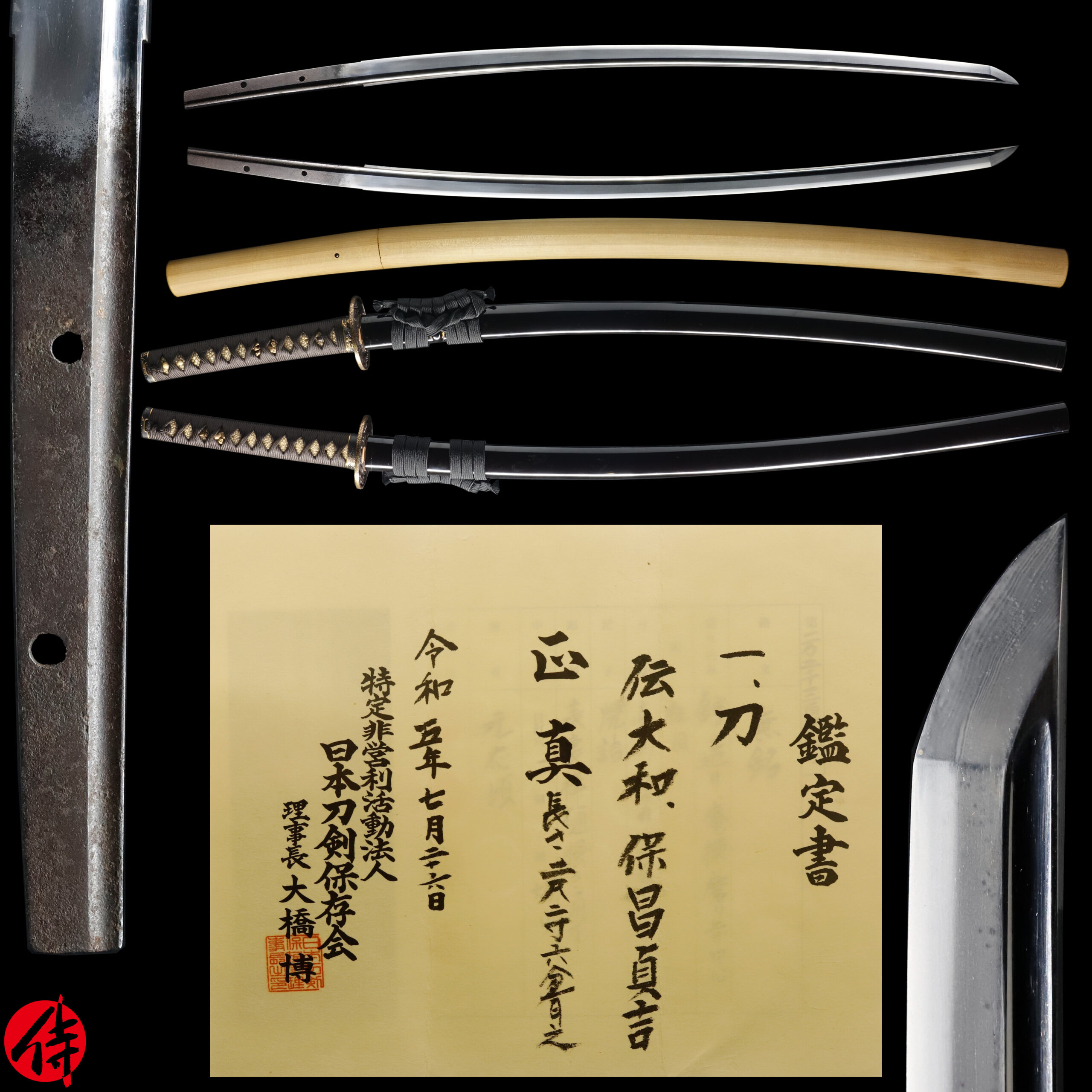
—————————————————————–
【About us】
Samurai Museum is located in Tokyo, Japan, exhibiting antique artifacts related to the Samurai history. Samurai Museum Shop is the place for those who are interested in Japanese culture and craftsmanship. We deal with antique Samurai swords/armor, traditional crafts made in Japan and so on.
【Japanese Sword& Export Process】
The Japanese swords we deal with are hand-forged edged swords made in Japan. It was made from the traditional carbon steel called TAMAHAGANE(玉鋼). Samurai Museum is familiar with the proper legal procedure for an antique/ authentic Japanese sword to be exported from Japan. We have sent more than 500 Japanese swords for the past three years (~2023) to amazing owners who appreciate its historical value.
Each Japanese sword is registered under the Agency for Cultural Affairs and the Board of Education in Japan. They issue a registration paper for each Japanese sword for its owner in Japan to legally possess it. The Japanese sword with its registration paper means it was traditionally hand-forged in Japan.
To legally export the sword from Japan to other countries, we will have to apply for its permit to the Agency for Cultural Affairs(Bunkacho) and return the original registration paper to the Board of Education. It normally takes around 2-4 weeks to receive this permit after submitting required documents. And we would like you to expect at least 1-1.5 months for your order to arrive at your given address after you ordered. For more detailed info, please click here.
It is allowed for residents in Japan to own authentic Japanese swords without a special license as long as they come with registration papers. Please feel free to contact us if you are a resident of Japan, whether temporarily or permanently. We will also assist you when you leave Japan and need to obtain the export permit.
【Payment Method】
We accept payment through Stripe (Credit card), PayPal, Apple Pay or ChromePay, all of which are secure payment methods. Also, you don’t need to make an account on Stripe for the checkout. If you prefer other payment method, please contact us. After confirming your payment, we will apply for an export permit. You may either pay in JPY, USD, AUD, CAD,EUR CHF or GBP. The price is set in Japanese Yen. Prices in other currencies are automatically calculated based on the latest exchange rate.

* If the amount is above 1 million JPY, Stripe or wire transfer will be the only options for payment.
【Shipping】
We have shipped authentic Japanese swords to the USA, UK, Canada, Mexico, Germany, France, Hong Kong and Australia. If you don’t live in these countries and like to order, please contact us first before making a purchase. We offer Free International Shipping as long as we can send antique Japanese swords by EMS.
We normally ship by EMS(Express Mail Service) provided by Japan Post. We will send you a tracking number for your order as soon as we hand it to the post office. We will put 100 % insurance on the shipping document without any extra charge. Based on the total amount, there might be a duty tax or other fee for you to pay, depending on the countries. We use package cushioning to protect the item and put it in a PVC pipe, which is one of the most secure packages because of its durability.
It will normally takes 5-14 days for the item to arrive at your given address after we dispatch it. Time of delivery is estimated as accurately as possible by the carrier but does not take into account any delays beyond our control such as by inclement weather, post office holiday seasons.
* If you live in Australia and like to purchase an authentic Japanese sword, please click here to know the detail.
*Please keep in mind that due to the spread of COVID-19, there might be delays in shipping. If you like to know the detail about shipping, please feel free to ask us.

【Review】
Here is one of the reviews we received from a customer who purchased an authentic Japanese sword from us. For more reviews, please click here.
“My experience overall with the whole process was wonderful. I had many questions about the history and process to purchase these treasures. All my questions were answered very timely and complete. The staff is very knowledgeable and very well versed if any questions do arise.”
【How to make sure the condition】
Please keep in mind that what you are going to purchase is an antique item. We uploaded high resolution photos for you to check its condition thoroughly. If you like to see more photos with different angles, please feel free to contact us. We will be happy to send them to you so that you can make informed decision. It is essential for us to know that you are happy with your choice of a sword. and we are prepared to use the best of our ability to serve you.
【How To Contact Us】
Please contact us through email, Facebook Messenger or Live Chat if you have any questions. You can find each icon on the right side of the website. Please click one of them to reach us. We will reply to you within 1-2 business days.
【The Art of Nihonto (Japanese Sword)】
Samurai’s history is a profound, eloquent legacy of ancient Japanese warriors in which millions of people worldwide are being fascinated. If you like to find out the art of Nihonto, please click here.
【A Guide to Japanese Sword Maintenance】
After acquiring an genuine Japanese sword, it is also important to know how to take good care of it. Here is the special video for you. Mr. Paul Martin, Japanese sword expert, shows you how to give proper maintenance to your sword. By mastering how to clean the Japanese sword, its aesthetic beauty will last forever.
When you purchase a Japanese sword from us, you can get a Free Japanese sword maintenance kit. It comes with four tools(Choji Oil, Uchiko Whetstone Powder, Peg remover, Oil Applicator). By watching the video instruction above , you can enjoy learning how to maintain your Japanese sword while appreciating it. If you have any difficulty assembling the sword or cleaning the blade, you can feel free to contact us.


MORE ANTIQUE JAPANESE SWORD FOR SALE
SWORDS WITHOUT CERTIFICATES FOR SALE
LEARN JAPANESE SWORD TERMINOLOGY
Thank you for reading all the information on the page. If you have any difficulty choosing the right Japanese sword for you, we will be more than happy to help you find the one that speaks to you the most. Please feel free to contact us.
